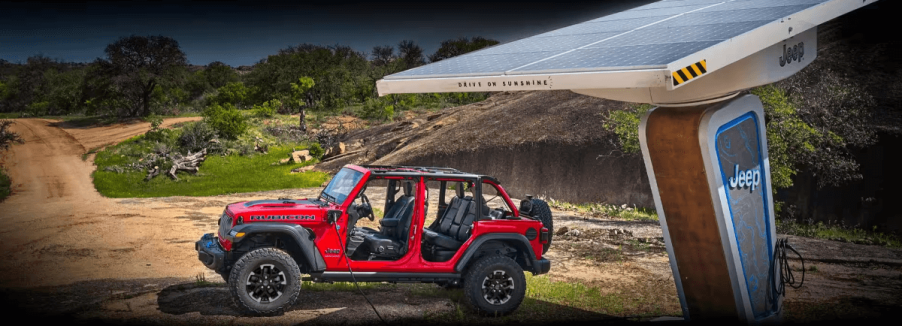
Is the 2024 Jeep Wrangler Rubicon X 4xe Really Worth Nearly $70K?
Some vehicle prices seem imminently reasonable as they align with closely competing vehicles and previous-generation models. However, sometimes, new models come with steep prices, and it’s not immediately clear whether they’re justifiable. That’s often the case with completely electrified versions of classic vehicles. The brand-new 2024 Jeep Wrangler 4xe is the plug-in hybrid (PHEV) version of the renowned Jeep Wrangler. Additionally, its top trim, the Rubicon X, has a starting price of nearly $70,000. So, is it worth it?
A look at the 2024 Jeep Wrangler Rubicon X 4xe
Before examining the Rubicon X 4xe, it’s a good idea to consider what a conventional 2024 Jeep Wrangler is worth and its costs. A base model two-door Sport starts at $31,895. Meanwhile, the base trim Sport S 4xe PHEV model starts at $49,995, and the ICE-powered Rubicon X starts at $55,490.
The Jeep Rubicon X comes with a choice of four powertrains, ranging from a 270-hp 2.0-liter turbocharged I-4 to the 470-hp 6.4-liter Hemi V-8, as well as either a six-speed manual or an eight-speed automatic transmission. 4WD is standard, as is a full float rear axle that increases the Rubicon X’s towing capacity.
Only available as a four-door model, the Jeep Wrangler Rubicon X 4xe PHEV has a starting MSRP of $69,680. It has a powertrain that combines the 2.0-liter I-4 with dual electric motors and a 17.3-kWh battery to produce 375 hp. The Rubicon X4xe has a combined 49 MPGe fuel efficiency and can provide drivers with up to 22 miles of electric-only range.
The Rubicon X trim neither claims the most interior room nor comfort in the segment. However, it is undoubtedly one of the most capable and versatile. You can remove both the roof and doors for extra accessibility and viewing. The Rubicon X includes a solid infotainment package through a 12.3-inch touchscreen and includes wireless Android Auto and Apple CarPlay. Onboard navigation and noise cancellation are standard features that should help you get to your destination relatively seamlessly.
Even at the premium Rubicon X trim, the Wrangler doesn’t offer much in the way of standard advanced safety systems. Features like blind-spot monitoring require an upcharge. Additionally, while Jeep provides three years of complimentary maintenance, its limited and powertrain warranty packages are pretty average (three years/36,000 miles and five years/60,000 miles, respectively). Other rivals offer more in both these arenas. Still, the Rubicon X is a strong competitor, with overall capabilities few can match.
What do reviewers say about the Rubicon X, 4xe, and Rubicon X 4xe?
Given that there’s not much difference between the Rubicon X and Rubicon X 4xe besides the hybrid powertrain and a sizable price increase, is the 4xe model/upgrade worth it? MotorTrend certainly thinks so. The outlet praises the PHEV’s capabilities, noting that the 4xe runs just as well on battery power as on engine power. They also note that the battery’s weight offers more stability to the vehicle.
Car and Driver recommends the turbocharged four-cylinder option, given a preference for Wranglers close to the vehicle’s military roots. While recommending the Sport S ICE model, the outlet doesn’t disparage the PHEV, noting that the hybrid option is for those who would prefer a more efficient off-roader. Additionally, CNET offers considerable praise for the Sport S 4xe trim, which at $51,790, is more affordable than the Rubicon X 4xe. Of course, it lacks many of the Rubicon X’s amenities, such as the full float rear axle, 35-inch tires, an integrated camera, steel bumpers, and other off-road capabilities.
Other similar sports utility vehicles
Jeep has been relatively slow to electrify its offerings compared to its rivals. Competitors like Toyota, Volvo, and Lincoln, among others, have beaten it to the punch with hybrids and PHEVs that have already seen several model years. The Toyota RAV4 Hybrid, for example, has been around since the 2019 model year (with an even earlier RAV4 offering a hybrid powertrain, but without the name and branding).
Now, the automaker has the Toyota RAV4 Prime plug-in hybrid compact SUV, noted for its quick acceleration (0 to 60 mph time of 5.4 seconds), 40-mile battery-only range, and fuel efficiency (38 mpg combined, 94 MPGe). You won’t get the same off-road versatility as the Wrangler, but if you’re looking for an affordable and reliable PHEV, the RAV4 Prime is certainly an option.
Another set of SUVs to consider? The Volvo Recharge models. While the C40 Recharge and XC40 Recharge are pure EVs (along with the upcoming EX90 and E30), all other Recharge-branded models in the Volvo lineup are PHEVs. That includes plug-in hybrid versions of the XC60 and XC90 SUVs, S60 and S90 sedans, and the V60 wagon.
Lincoln’s Aviator PHEV also deserves a test drive. It’s certainly not going to have you climbing rough back roads comfortably, but it will have you riding in quite a bit of comfort. The Aviator sports such features as 30-way adjustable seats, approach lights, and an air suspension feature that allows the vehicle to lower itself so riders can enter and exit more easily. The PHEV sports a 3.0-liter twin-turbo V-6 and an electric motor generating 494 hp.
None of these vehicles will match a Jeep Wrangler Rubicon in the woods. However, for those looking for powerful, reliable, and high-quality PHEV SUVs, there’s more than just the Wrangler Rubicon X 4xe available to buy.


